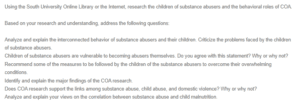Children of Substance Abusers
In many cases, children of substance abusers face challenges ranging from poor care to the possibility of abuse and becoming addicted themselves. Substance abusers, in most cases, misuse their finances and family resources for their addiction, and this means the children may lack basic needs or live under poor standards. Also, substance abusers may not give quality care to their children when under the influence of substances. In some cases, substance abusers can become abusive to their children, especially when they are under the influence. Fields (2016) has also pointed out that children of substance abusers are likely to begin using the same substances early and eventually become addicts. Children of substance abusers can face financial hardships, neglect, and even physical and emotional abuse. In addition to these challenges, the addictive tendencies of the parent can cause stress on the child.
Several reasons support the fact that children of abusers are likely to abuse substances. The first proof of this is the lifestyle, as seen in the study by Solis et al. (2012). The drug-using lifestyle swiftly teaches children how to abuse drugs. There are many cases where children develop alcoholism because their parents also have alcoholism. There are also cases where children learn to use substances that they see their parents abusing. Additionally, children can abuse substances due to mental issues brought about by their childhood life under a parent who is using substances.
The overwhelming conditions that children raised by substance abusers experience can be managed by talking about their difficulties. They need a trusted person like their school teacher, religious leader, or coach to discuss their challenges. To keep away from these challenges, the children being raised by substance abusers can keep away from the substances by engaging in activities in school or their religious centers. The activities may include sports, music, and art. These children can also be allowed to write about the challenges they go through to express their emotions. It should be noted that growing up under parents who abuse substances can cause post-traumatic stress disorder (PTSD) (Ross, 2014), which greatly affects families and children.
When analyzing the major findings of the COA studies, one will observe that in the last two decades, researchers have realized that children brought up by alcohol abusers are considered “codefendants”. The study also claims that alcoholism can result from genetics and further added that psychological, environmental, and social factors can be attributed to substance abuse tendencies among children (Solis et al., 2012). One important thing they point out is that children of abusers always start by showing delinquent tendencies. Studies also show that children brought up by parents who are alcohol or substance abusers are often victimized, and this increases their chances of having mental illnesses and a predisposition to alcohol abuse (Solis et al., 2012).
An analysis of the COA research shows a connection between substance abuse, domestic abuse, and domestic violence. The research shows and proves that parents who are abusers of substances and drugs often fail to show traits of good parenting (Ross, 2014). The reason they are often not able to parent well is because they are under the influence of the substances they use. Substance abusers can behave erratically, and sometimes, they neglect and abuse their children. This trend of drug-abusing parents can lead the child to substance abuse in the future since children who are abused or neglected are highly likely to engage in drugs and substance abuse.
I believe there is a direct connection between malnourishment and substance abuse. When a parent, especially a mother, is addicted to substances, they often forget to offer proper care to their children. Part of the things they fail to give their children is healthy food. Therefore, the child ends up malnourished. In some cases, if the parent is lactating, the drug or alcohol addiction problem might put the infant at risk for malnutrition. This can happen when the mother is using drugs that suppress milk production thus depriving the child of its food (Solis et al., 2012). Also, there are instances where the child may not feed well because of the emotional and psychological issues in the family. When parents are alcohol and substance abusers, the environment is toxic, thus making it difficult for the child to eat well.
References
Fields, R. (2016). Drugs in perspective: Causes, assessment, family, prevention, intervention, and treatment. McGraw Hill.
Ross, L. E. (2014). The war against domestic violence (1st ed.). CRC Press.
Solis, M. J., Shadur, M. J., Burns, R. A., & Hussong, M. A. (2012). Understanding the diverse needs of children whose parents abuse substances. Current Drug Abuse Reviewse, 5(2), 135–147. https://doi.org/10.2174/1874473711205020135
ORDER A PLAGIARISM-FREE PAPER HERE
We’ll write everything from scratch
Question

Children of Substance Abusers
Using the South University Online Library or the Internet, research the children of substance abusers and the behavioral roles of COA.
Based on your research and understanding, address the following questions:
Analyze and explain the interconnected behavior of substance abusers and their children. Criticize the problems faced by the children of substance abusers.
Children of substance abusers are vulnerable to becoming abusers themselves. Do you agree with this statement? Why or why not?
Recommend some of the measures to be followed by the children of the substance abusers to overcome their overwhelming conditions.
Identify and explain the major findings of the COA research.
Does COA research support the links among substance abuse, child abuse, and domestic violence? Why or why not?
Analyze and explain your views on the correlation between substance abuse and child malnutrition.

